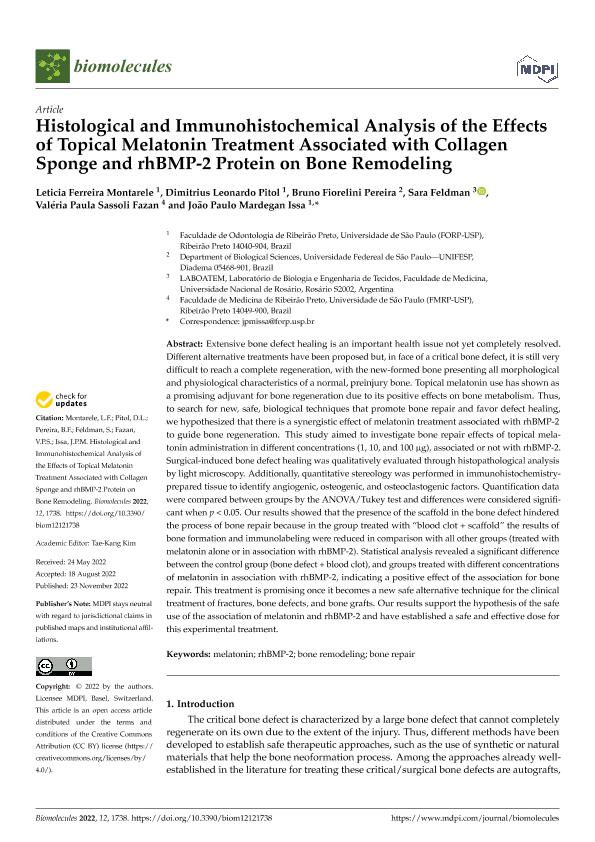Mostrar el registro sencillo del ítem
dc.contributor.author
Ferreira Montarele, Leticia
dc.contributor.author
Pitol, Dimitrius Leonardo
dc.contributor.author
Fiorelini Pereira, Bruno
dc.contributor.author
Feldman, Sara

dc.contributor.author
Sassoli Fazan, Valéria Paula
dc.contributor.author
Mardegan Issa, João Paulo
dc.date.available
2023-11-23T14:55:41Z
dc.date.issued
2022-12
dc.identifier.citation
Ferreira Montarele, Leticia; Pitol, Dimitrius Leonardo; Fiorelini Pereira, Bruno; Feldman, Sara; Sassoli Fazan, Valéria Paula ; et al.; Histological and Immunohistochemical Analysis of the Effects of Topical Melatonin Treatment Associated with Collagen Sponge and rhBMP-2 Protein on Bone Remodeling; Multidisciplinary Digital Publishing Institute; Biomolecules; 12; 12; 12-2022; 1-16
dc.identifier.issn
2218-273X
dc.identifier.uri
http://hdl.handle.net/11336/218534
dc.description.abstract
Extensive bone defect healing is an important health issue not yet completely resolved. Different alternative treatments have been proposed but, in face of a critical bone defect, it is still very difficult to reach a complete regeneration, with the new-formed bone presenting all morphological and physiological characteristics of a normal, preinjury bone. Topical melatonin use has shown as a promising adjuvant for bone regeneration due to its positive effects on bone metabolism. Thus, to search for new, safe, biological techniques that promote bone repair and favor defect healing, we hypothesized that there is a synergistic effect of melatonin treatment associated with rhBMP-2 to guide bone regeneration. This study aimed to investigate bone repair effects of topical melatonin administration in different concentrations (1, 10, and 100 µg), associated or not with rhBMP-2. Surgical-induced bone defect healing was qualitatively evaluated through histopathological analysis by light microscopy. Additionally, quantitative stereology was performed in immunohistochemistry-prepared tissue to identify angiogenic, osteogenic, and osteoclastogenic factors. Quantification data were compared between groups by the ANOVA/Tukey test and differences were considered significant when p < 0.05. Our results showed that the presence of the scaffold in the bone defect hindered the process of bone repair because in the group treated with “blood clot + scaffold” the results of bone formation and immunolabeling were reduced in comparison with all other groups (treated with melatonin alone or in association with rhBMP-2). Statistical analysis revealed a significant difference between the control group (bone defect + blood clot), and groups treated with different concentrations of melatonin in association with rhBMP-2, indicating a positive effect of the association for bone repair. This treatment is promising once it becomes a new safe alternative technique for the clinical treatment of fractures, bone defects, and bone grafts. Our results support the hypothesis of the safe use of the association of melatonin and rhBMP-2 and have established a safe and effective dose for this experimental treatment.
dc.format
application/pdf
dc.language.iso
eng
dc.publisher
Multidisciplinary Digital Publishing Institute
dc.rights
info:eu-repo/semantics/openAccess
dc.rights.uri
https://creativecommons.org/licenses/by/2.5/ar/
dc.subject
BONE REMODELING
dc.subject
BONE REPAIR
dc.subject
MELATONIN
dc.subject
RHBMP-2
dc.subject.classification
Otras Ciencias de la Salud

dc.subject.classification
Ciencias de la Salud

dc.subject.classification
CIENCIAS MÉDICAS Y DE LA SALUD

dc.title
Histological and Immunohistochemical Analysis of the Effects of Topical Melatonin Treatment Associated with Collagen Sponge and rhBMP-2 Protein on Bone Remodeling
dc.type
info:eu-repo/semantics/article
dc.type
info:ar-repo/semantics/artículo
dc.type
info:eu-repo/semantics/publishedVersion
dc.date.updated
2023-11-15T16:02:07Z
dc.journal.volume
12
dc.journal.number
12
dc.journal.pagination
1-16
dc.journal.pais
Suiza

dc.journal.ciudad
Basilea
dc.description.fil
Fil: Ferreira Montarele, Leticia. Universidade de Sao Paulo; Brasil
dc.description.fil
Fil: Pitol, Dimitrius Leonardo. Universidade de Sao Paulo; Brasil
dc.description.fil
Fil: Fiorelini Pereira, Bruno. Universidade Federal de Sao Paulo; Brasil
dc.description.fil
Fil: Feldman, Sara. Universidad Nacional de Rosario. Facultad de Cs.medicas. Laboratorio de Biologia Osteoarticular, Ingenieria Tisular y Terapias Emergentes; Argentina. Consejo Nacional de Investigaciones Científicas y Técnicas. Centro Científico Tecnológico Conicet - Rosario; Argentina
dc.description.fil
Fil: Sassoli Fazan, Valéria Paula. Universidade de Sao Paulo; Brasil
dc.description.fil
Fil: Mardegan Issa, João Paulo. Universidade de Sao Paulo; Brasil
dc.journal.title
Biomolecules
dc.relation.alternativeid
info:eu-repo/semantics/altIdentifier/url/https://www.mdpi.com/2218-273X/12/12/1738
dc.relation.alternativeid
info:eu-repo/semantics/altIdentifier/doi/https://doi.org/10.3390/biom12121738
Archivos asociados
